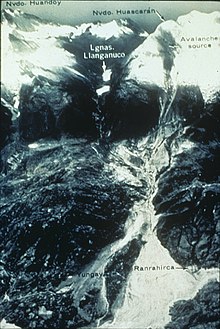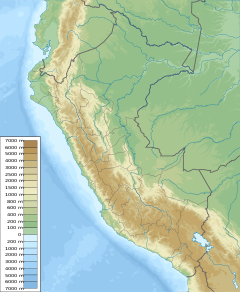|
Huascarán
Huascarán (Spanish pronunciation: [waskaˈɾan]), (Quechua: Waskaran), Nevado Huascarán or Mataraju is a mountain located in Yungay Province, Department of Ancash, Peru. It is situated in the Cordillera Blanca range of the western Andes. The southern summit of Huascarán (Huascarán Sur), which reaches 6,768 metres (22,205 ft), is the highest point in Peru, the northern Andes (north of Lake Titicaca), and in all of the earth's Tropics. Huascarán is the 4th highest mountain in South America after Aconcagua, Ojos del Salado, and Monte Pissis. Huascarán is ranked 25th by topographic isolation. NameUntil the 20th century, the mountain lacked a single commonly accepted name but it was rather known by different names within the surrounding towns and villages. The first recorded mention of the name Huascaran appeared in 1850 as Huascan,[3] name given by the local people likely because the mountain rises above the village of Huashco, Huashco getting its name from the Quechua word for rope (waska). At the beginning of the 20th century, the name appeared as Huascarán, a form which has not since changed.[4] It seems that the name Huascarán is merely a contraction of Huashco-Urán. When the mountain was mentioned, it was thought of in connection with the village and was called Huashco-Urán or “Beyond and down from the village of Huashco.”[5] Other names given to the mountain were Matarao and Mataraju, Mataraju being the name by which the local indigenous inhabitants prefer to call the mountain,[6] from Ancash Quechua mata (twin) and rahu (snow peak), meaning 'twin snow peaks'. MythHuascarán was a noble man who lived in a certain place in Áncash, while Huandoy was a woman who lived in a small town very close to where this mountain is now. Huascarán was enormously in love with the girl, so they always saw each other secretly. One day Huascarán's father found out that he was in love with the little woman, so he asked the Sun God for help. Seeing that he could not separate the two lovers, he decided to turn them into mountains, but the divinity decided to bring them together so that despite their being mountains they continued with their love.[citation needed] GeographyThe mountain has two distinct summits, the higher being the south one (Huascarán Sur) with an elevation of 6,768 metres (22,205 ft).[1] The north summit (Huascarán Norte) has an elevation of 6,654 meters (21,831 ft).[1] The two summits are separated by a saddle (called 'Garganta'). The core of Huascarán, like much of the Cordillera Blanca, consists of Cenozoic granite.[7] Huascarán gives its name to Huascarán National Park which surrounds it, and is a popular location for trekking and mountaineering. The Huascarán summit is one of the points on the Earth's surface farthest from the Earth's center,[8] closely behind the farthest point, Chimborazo in Ecuador.[1] The summit of Huascarán is the place on Earth with the smallest gravitational force,[9] with an estimated acceleration of 9.76392 m/s2.[10] Climbing Huascarán is normally climbed from the village of Musho to the west via a high camp in the col that separates the two summits, known as La Garganta. The ascent normally takes five to seven days, the main difficulties being the large crevasses that often block the route.[11] The normal route is of moderate difficulty and rated between PD and AD (depending on the conditions of the mountain) according to the International French Adjectival System. On July 20, 2016, nine climbers were caught in an avalanche on Huascarán's normal route at approximately 5,800 m (19,000 ft), four of whom died.[12] On July 9th, 2024, it was reported that the body of William Stampfl, an American mountaineer, had been found 22 years after he disappeared in an avalanche in June 2002.[13] The body of one of Stampfl's climbing companions had previously been recovered. A third member of the group is still unaccounted for.[14] HistoryThe summit of Huascarán Sur was first reached on 20 July 1932 by a joint German–Austrian expedition.[15] The team followed what would become later the normal route (named today Garganta route). The north peak (Huascarán Norte) had previously been climbed on 2 September 1908 by a U.S. expedition that included Annie Smith Peck,[16] though this first ascent is somewhat disputed. In 1989, a group of eight amateur mountaineers, the "Social Climbers", held what was recognized by the Guinness Book of Records (1990 edition) to be "the world's highest dinner party" on top of the mountain, as documented by Chris Darwin and John Amy in their book The Social Climbers, and raised £10,000 for charity.[17][18] Huascarán NorteApart from the normal route, climbed in 1908 and rated PD+/AD-, all the other routes are committing and serious.
Huascarán SurAs for the South summit, apart from the normal route all the others are difficult.
1970 earthquake On 31 May 1970, the Ancash earthquake caused a substantial part of the north side of the mountain to collapse in an avalanche with an estimated 80 million cubic metres (2.8 billion cubic feet) of ice, mud and rock, measured about 0.8 by 1.6 kilometres (0.5 mi × 1 mi). It advanced about 18 km (11 mi) at an average speed of 280 to 335 km/h (175 to 210 mph),[19] burying the towns of Yungay and Ranrahirca under ice and rock, killing more than 20,000 people.[20][21] At least 20,000 people were also killed in Huaraz, site of a 1941 avalanche (see Palcacocha Lake).[22] Estimates suggest that the earthquake killed over 66,000 people.[23][24] The final toll was 67,000 dead and 800,000 homeless, making this the worst earthquake-induced disaster in the Western Hemisphere until the 2010 Haiti earthquake. Also buried by an avalanche was a Czechoslovak mountaineering team, none of whose 15 members were ever seen again.[25] This and other earthquake-induced avalanche events are often described[by whom?] evocatively as "eruptions" of Huascarán, despite not being of volcanic origin. An earlier avalanche on January 10, 1962, caused by a rapid rise in temperature,[22] killed an estimated 4,000 people.[26] See alsoBibliography
References
External links |
||||||||||||||||||||||||||||||||||||

